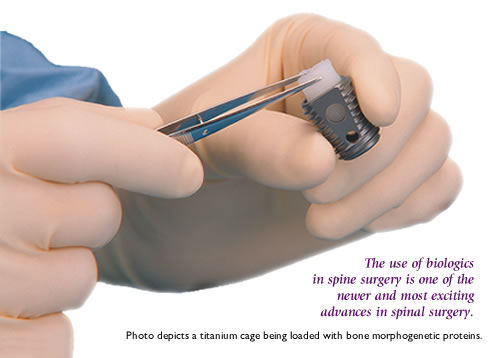Biologics in Spine Surgery
T. Sunil Thomas, MD
Spine Surgery
Eau Claire Spine & Orthopedics
Eau Claire
The use of biologics in spine surgery is one of the newer and most exciting advances in spinal surgery. Biologics can work in one of two ways, either by assisting the body’s natural processes to aid in healing or as products that can heal diseased or degenerated discs.
In spinal fusions, instrumentation (“metal”) is used to assist in healing of the fusion by providing stabilization, but it does not stimulate any of the cells to produce bone. Metal is an inert material. Proteins that can attract and stimulate cells to produce bone and promote fusion would be considered a biological material.
“These proteins are very powerful differentiation factors that stimulate bone growth and spinal fusion. They can be used in conjunction with the patient’s own bone (autograft) or with donated bone (allograft).”
Bone morphogenetic proteins (“BMP’s”) are biologics currently used in spinal surgery. These proteins are very powerful differentiation factors that stimulate bone growth and spinal fusion. They can be used in conjunction with the patient’s own bone (autograft) or with donated bone (allograft). When the patient’s own bone is spared, it can reduce the pain and side effects associated with harvesting the patient’s bone. The FDA has approved BMPs for use in single level anterior (front of the spine) lumbar spinal fusions when used inside a titanium cage. BMP’s are currently being evaluated for use in all areas of the spine, from neck to lower back, and although results from studies are encouraging, they still have to be compared with and outperform the gold standard, which is the use of autograft. As the efficacy of BMP and other graft substitutes are shown, the use of autograft will most likely diminish.
Another biologic product that can be used is stem cells from the patient’s own bone marrow. Bone marrow cells are removed from the patient and by concentrating these cells and placing them on donor bone (allograft), this can replace the patients own bone in trying to achieve spinal fusion.
Over the next five to six years, several biological material advances will improve the treatment of spinal disorders.
The future of biologics in spinal surgery involves use of gene therapy techniques, both to assist in spinal fusion and also potentially to repair damaged discs, thus avoiding performing a fusion and thereby the loss of motion. However, more research and a better understanding of the biological process involved in spinal disease is needed before practical applications can be developed.
Our current goal with the use of biologics has been to reduce morbidity (less complications) and improve outcomes (better results). In the future, as biologics are improved and refined, we may be able to use them with smaller incisions thus reducing pain and promoting faster recovery from spinal surgery.
Dr. Thomas – Eau Claire Spine & Orthopedics
For information or to schedule an appointment:
715-858-0320 | www.oakleafmedical.com
Dr. Thomas sees patients in Eau Claire and St. Croix Falls.






 © 2009 OakLeaf Medical Network and OakLeaf Surgical Hospital. All rights reserved.
© 2009 OakLeaf Medical Network and OakLeaf Surgical Hospital. All rights reserved.